Physical Address
304 North Cardinal St.
Dorchester Center, MA 02124
Physical Address
304 North Cardinal St.
Dorchester Center, MA 02124
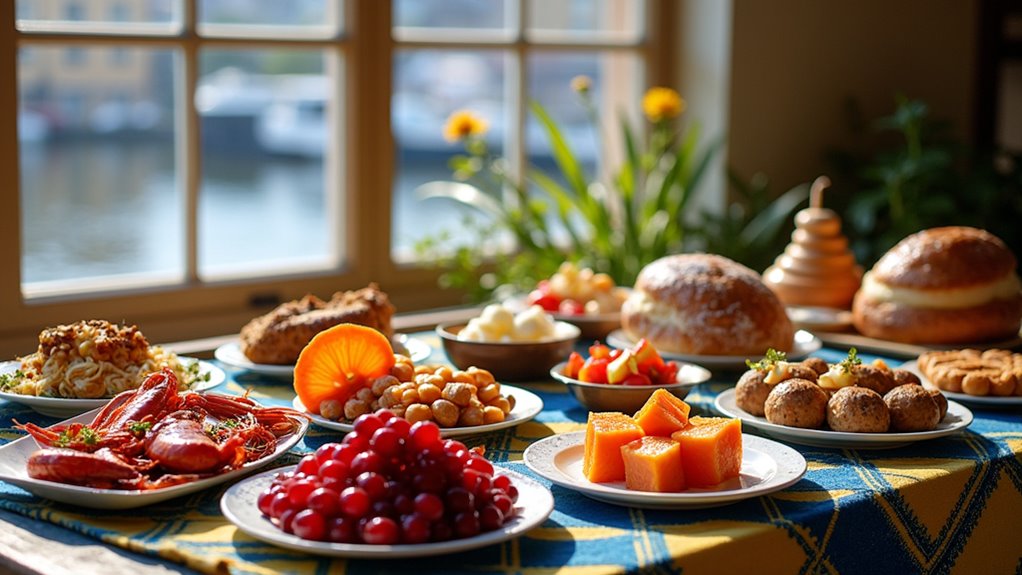
Authentic Swedish cuisine goes beyond meatballs, offering unexpected delights that will transform your understanding of Nordic food.
Swedish cuisine celebrates both simplicity and tradition. You’ll find iconic dishes like köttbullar (meatballs) served with lingonberry jam, smörgåstårta (sandwich cake) for celebrations, and gravad lax (dill-cured salmon) on any festive table. Don’t miss kanelbullar (cinnamon buns), Janssons frestelse (potato-anchovy casserole), or the divisive surströmming (fermented herring). Swedish food culture blends resourceful cooking with seasonal ingredients, reflecting values of community and celebration. Discover how these classic dishes tell the story of Nordic culinary heritage.
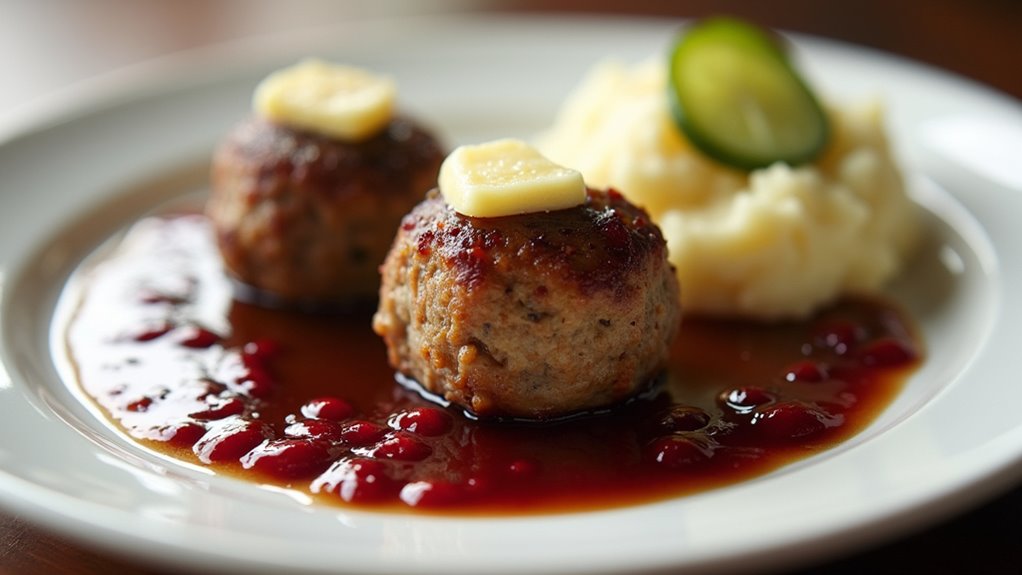
When you think of Swedish cuisine, köttbullar—Sweden’s iconic meatballs—likely come to mind first. These small, tender spheres combine beef and pork with breadcrumbs, egg, and grated onion for the perfect texture.
Köttbullar—Sweden’s beloved meatballs—showcase the perfect union of beef and pork with aromatic spices in every tender bite.
The distinctive flavor comes from allspice and nutmeg, with white pepper providing subtle heat. Many home cooks find that the unique combination of spices including nutmeg and ginger creates the authentic Swedish flavor profile that makes this dish so beloved.
Traditionally pan-fried in butter until golden brown, köttbullar are simmered in an opulent cream gravy made from pan drippings.
You’ll always find them served with tart lingonberry jam and pickled cucumbers—the perfect sweet-sour complement to the savory meatballs.
Most Swedes pair them with fluffy mashed potatoes to soak up the delicious sauce.
Beyond their IKEA fame, köttbullar remain central to Swedish celebrations like Christmas and Midsummer, embodying the essence of Swedish home cooking. Much like how snorkeling spots are essential to Dubrovnik’s cultural identity, these meatballs are fundamental to Swedish culinary heritage.
While meatballs satisfy Swedish everyday cravings, the smörgåstårta represents Swedish celebration food at its most impressive. This sandwich cake, first appearing in 1934, has become a fixture at weddings, funerals, and anniversaries across Northern Europe.
You’ll find this cold dish meticulously constructed with layers of white or light rye bread, filled with combinations of egg, mayonnaise, meats, cheeses, and vegetables. Much like must-visit destinations, the smörgåstårta offers a rich cultural experience worth savoring.
The exterior receives a frosting of cream cheese or mayonnaise-based mixture, then gets decorated with herbs, salmon, eggs, or caviar to hint at flavors inside.
Preparation requires patience—at least two hours of refrigeration ensures structural integrity before the precision cutting begins. In Finland, this delightful creation known as voileipäkakku is especially popular at family gatherings.
While traditionally opulent and indulgent, modern variations now include vegetarian and vegan options, maintaining the smörgåstårta’s status as the centerpiece of Swedish celebratory dining.
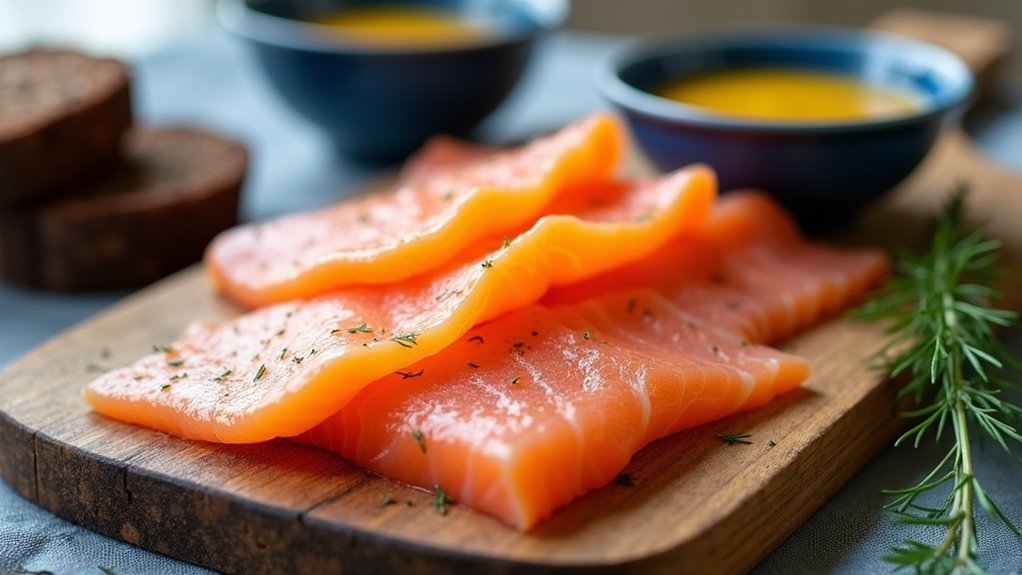
Deeply rooted in Nordic culinary heritage, gravad lax represents Swedish cuisine at its purest and most elegant form. This traditional dish evolved from medieval preservation techniques, where salmon was fermented underground (“grav” meaning grave). Today’s version uses a simple salt-sugar cure with fresh dill.
When you visit Sweden, you’ll find gravad lax:
The curing process takes 48-72 hours, during which the salt draws moisture from the fish while sugar and dill infuse it with their distinctive flavors. Premium salmon is essential for this delicacy. For modern home preparation, many chefs recommend vacuum packing the salmon during curing to promote more uniform flavor distribution throughout the fish. After enjoying this classic Swedish dish, many locals head to Stockholm’s bars to complete their culinary experience with traditional aquavit or craft beverages.
Named after a 1928 film rather than containing actual anchovies, Janssons Frestelse functions as one of Sweden’s most beloved comfort foods. This creamy potato casserole features thinly sliced potatoes layered with chopped onions and pickled sprats (commonly mislabeled as “ansjovis” but actually sweeter than true anchovies).
You’ll find this dish at virtually every Swedish Christmas and Easter buffet, where its golden, crispy top layer signals it’s been perfectly baked. Food writer Gunnar Stigmark claimed the name originated when his mother and a chef created it during a society dinner. The preparation involves careful layering in a roasting tin, seasoned with salt and pepper, then drenched in cream before baking at 200°C for about an hour. For those seeking a truly authentic experience, consider enjoying this dish during a winter holiday in one of Europe’s luxury destinations where traditional Nordic cuisine is celebrated.
The result marries salty fish with sweet cream for a uniquely Swedish flavor experience that’s stood the test of time since its recipe was first published in the 1940s.
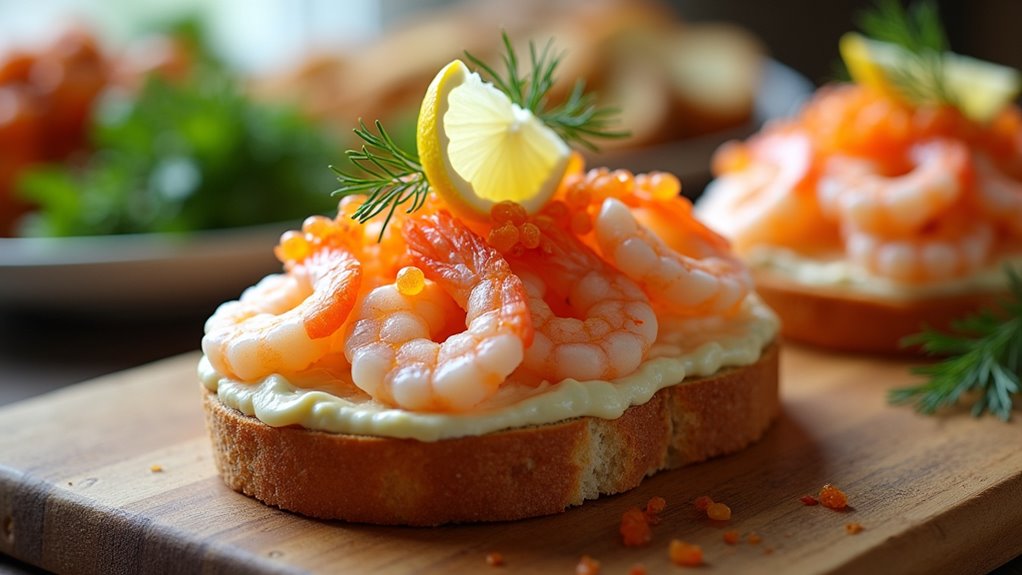
Created by renowned chef Tore Wretman in the 1950s, Toast Skagen represents the elegant simplicity that defines Swedish cuisine. This sophisticated appetizer features a delicious mixture of shrimp, mayonnaise, sour cream, dill, and other herbs piled atop buttered toast, then garnished with fish roe and lemon.
When you try this classic dish, you’ll experience:
Toast Skagen remains a staple at Swedish celebrations, especially Midsummer festivities. You’ll find it paired with white wine or aquavit for the complete experience. For an authentic preparation, the bread should be fried until golden on both sides in a pan with butter. Though simple to prepare, it’s become an internationally recognized symbol of Swedish culinary tradition. While enjoying your Toast Skagen in Sweden, it’s worth remembering that the country is home to relatively few dangerous animals compared to many other destinations.
Throughout Sweden’s centuries-old culinary heritage, few traditions have endured with as much cultural significance as “ärtsoppa och pannkakor,” the Thursday ritual of yellow pea soup followed by thin pancakes.
This practice dates back to the Middle Ages, originating from Catholic fasting traditions before Friday. Peas were once considered a luxury item and were specially prepared to sustain people through fasting days.
The hearty soup combines yellow peas, pork, onions, and herbs like marjoram and thyme, simmered to perfection.
It’s traditionally followed by thin pancakes served with strawberry jam and cream.
You’ll find this pairing in schools, military mess halls, and restaurants across Sweden, especially on Thursdays.
Sometimes accompanied by warm punsch for festivity, this meal creates a communal atmosphere deeply woven into Swedish identity.
Despite King Erik XIV’s famous (though unverified) arsenic poisoning by pea soup, the dish remains beloved nationwide.
This communal approach to food culture mirrors how Turks care for stray cats throughout their cities, demonstrating how culinary customs often reflect broader societal values.
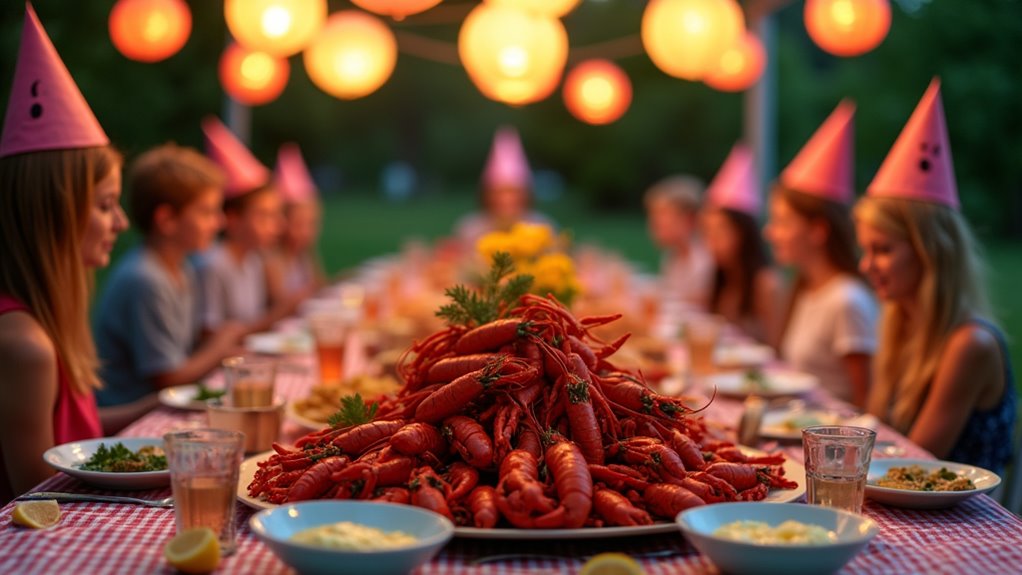
While winter brings the comfort of ärtsoppa och pannkakor, summer in Sweden offers its own culinary celebration with “kräftor med dill,” or crayfish with dill. This tradition, dating back to the 16th century Swedish royalty, has evolved into a beloved late summer ritual celebrating the August fishing season.
At a typical kräftskiva (crayfish party), you’ll experience:
These outdoor gatherings serve as a delicious farewell to summer, combining Sweden’s love for seasonal food, community, and cultural traditions. The event has an unmistakable messy charm, with guests encouraged to slurp the brine and suck the head of each crayfish.
No Swedish culinary tradition captures the essence of everyday comfort quite like kanelbullar, the fragrant cinnamon buns that have become synonymous with Swedish baking. These cardamom-infused, spiral-shaped treats emerged in the 1920s and remain a cornerstone of fika (coffee break) culture.
Unlike their American counterparts, authentic kanelbullar aren’t frosted but often topped with pearl sugar. The dough combines cardamom with a cinnamon-sugar-butter filling that creates their distinctive flavor profile. Following World War I, these pastries gained widespread popularity when economic recovery made previously luxurious ingredients like cinnamon more accessible to ordinary households.
Swedes celebrate their national treasure every October 4th during Kanelbullens dag.
For a regional specialty, visit Gothenburg’s Haga district, famous for oversized hagabullar. Whether enjoying them as part of a traditional fika or sampling modern variations with vanilla custard or chocolate, these beloved buns represent Swedish comfort food at its finest.

How can a food so reviled globally be treasured as a delicacy in its homeland? Surströmming, Sweden’s notorious fermented Baltic herring, dates back to 16th-century salt shortages and continues as a northern cultural tradition today. The fish ferments for months, creating distinctive bulging cans filled with pungent gases. The strong odor comes from a mixture of propionic and butyric acids produced during the fermentation process. This dish exemplifies the regional diversity found throughout European culinary traditions.
If you’re brave enough to try this delicacy:
Surströmming premieres annually on the third Thursday of August, when Swedes gather (typically outdoors) to celebrate this divisive culinary heritage that’s more than just a “stinky fish.”
Long before sustainability became trendy, Swedish farm families created blodpudding as a practical way to use every part of slaughtered animals. This dense, iron-rich dish combines pig or beef blood with rye flour, spices like cloves and ginger, and sweetened with dark corn syrup.
You’ll find blodpudding prepared by mixing strained, chilled blood with dry ingredients, then slow-baking at low temperatures. Once cooled, it’s sliced and pan-fried until crispy on the outside.
The traditional serving includes tart lingonberry jam and fried apples to balance the distinctive iron flavor. Often topped with crispy bacon and accompanied by white cabbage salad, this protein-packed dish remains culturally significant despite its decline in everyday Swedish cuisine. For home cooks interested in authentic preparation, many Asian markets and specialty butchers offer frozen blood needed for traditional recipes.
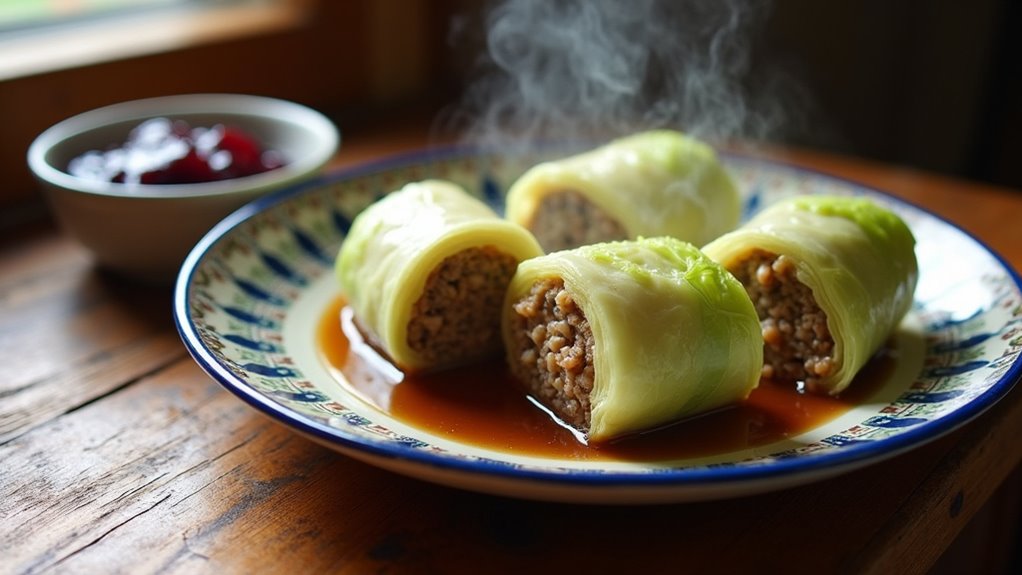
While blodpudding represents Sweden’s waste-not approach to animal products, kåldomar showcases similar resourcefulness with vegetables. Dating back to 18th-century Sweden with possible Ottoman influences, these cabbage rolls have evolved into a beloved comfort food that reflects the country’s practical cooking heritage.
Swedish cuisine brilliantly transforms humble ingredients into cherished dishes, whether using animal offcuts or simple vegetables.
To truly appreciate traditional kåldomar, note these key elements:
Much like Old Town Dubrovnik with its preserved cultural heritage, kåldomar represents an important piece of Swedish culinary tradition worth exploring.
Typically served with lingonberry jam and potatoes, kåldomar remains a cherished national dish that provides warmth and satisfaction during Sweden’s cold winter months.
Swedish cuisine will absolutely blow your mind with flavors you’ve never imagined! From the comfort of köttbullar to the terrifyingly pungent surströmming, you’ll find dishes that’ll make your taste buds dance or run for cover. Don’t just visit Sweden—eat your way through it! These eleven classics are just the beginning of a culinary adventure that’ll have you booking your next trip before you’ve even finished dessert.